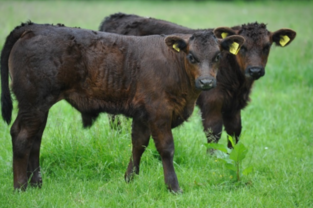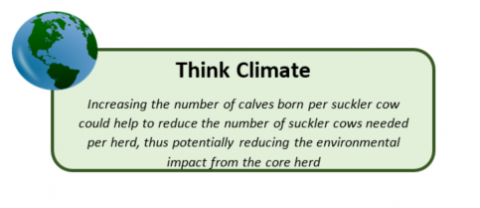Dr Ruth Wonfor: IBERS, Aberystwyth University
- Twinning in beef cattle has been suggested to be a way to increase profitability in suckler herds, by producing more calves from suckler cows.
- Genetic selection can be used to increase twinning rates, yet genetic gains are slow and must be completed over a number of generations. Quicker methods induce multiple ovulations or utilise embryo transfer from super-ovulated cows.
- There are many detrimental outcomes associated with twinning in beef cattle, which have effects on herd economics as well as cow and calf health. Therefore, before instigating a twinning system, the positives must be weighed against the negatives.
Twinning in cattle has been a much discussed subject in bovine reproduction, with research dating back
to the 1970’s. Most of this work has focussed around dairy cow reproduction, where twinning rate is higher than in beef cattle. In dairy cow production, increased twinning rate is seen as detrimental, reducing herd profitability. In high producing dairy cattle, twinning results in a longer calving to conception interval, higher pregnancy loss in the following lactation, greater probability of culling, shorter production lifespan and a greater incidence of postpartum disease, such as dystocia and retained foetal membrane. Freemartin syndrome poses a further issue if not using sexed semen. Different sex twins from cattle renders the female infertile due to passing of male hormones from the male foetus to the female foetus. For dairy cow production, this leaves the potential female replacement heifer infertile and therefore of no future economic benefit to the herd.The idea of twinning in beef suckler herds has been considered more recently as an option for improving calving productivity and therefore profitability from less animals in the herd. It must be noted that only 50% of multiple ovulations that occur do yield a twin birth, which is related to a number of reasons as described later.
As calves from suckler herds are bred for meat production, the issues surrounding Freemartins are not as important as in dairy systems, unless the calf is required for the future breeding programme. Indeed, Freemartin calves have previously been shown to be heavier than normal twins at birth, and daily growth rates were similar to twins and singles.
Environmental consequences of farming practices must always be considered before implementation. Incorporation of greenhouse gas with economic data, demonstrated twinning to be non-beneficial, as the environmental impact of producing more calves on the farm decreased the economic benefits. However, it was unclear whether this study took into account that by increasing the number of calves from one cow, the main herd could be reduced. Thus, several factors combined, including less cows in the herd to emit and a reduction in required feed production, would theoretically reduce the greenhouse gas emissions of the farm. This requires further investigation in the future.
Ways to implement an increase in twinning rates.
Natural twinning rate is usually low in beef herds, although, as with dairy cows, the percentage of multiple ovulations and therefore potential to produce twins increases with age and parity. If aiming to improve the twinning rate within a suckler herd, there are three potential mechanisms which should be considered. Before deciding to implement any of these systems, always consult your vet.
Genetic selection
Specifically selecting for twins in a breeding programme is possible, but is a timely exercise. Several research studies have investigated the genetics behind twinning rate, yet this has mainly been completed in dairy cows. Ovulation rate dictates the number of embryos, with the majority of cattle twins being dizygotic (fraternal - developing from two different eggs), therefore selecting for multiple ovulations has been used to improve twinning rate. However, genetic gains are slow due to relatively low heritability estimates for multiple ovulation and twinning rate. The US Meat Animal Research Centre (USMARC) has a successful breeding scheme for a ‘twinner population’, which is a composite of 9 cattle breeds, selected over 4-5 generations on estimated breeding values for twinning. The work at USMARC has therefore shown that genetic selection for a twinning herd is possible, but that it is a lengthy process.
Hormonal control of multiple ovulation
Hormonal treatments are commonly used for manipulation of reproduction in cattle breeding programmes. Several protocols have been developed to induce multiple ovulations in cattle.
Folliculogenesis is a biological process that occurs in the ovary to select follicles, which contain eggs to be ovulated. Within this process, follicle-stimulating hormone (FSH) is an essential hormone. Therefore, there is the potential for the use of FSH to be manipulated to increase the number of follicles which are selected and therefore the number of eggs to be ovulated, thus increasing the potential to fertilise two eggs, resulting in twins. Recent research developed a protocol utilising FSH to induce double or triple ovulations in heifers. However, of the follicles which appeared to be successfully developing with the protocol, only 60% were healthy and demonstrated the potential to carry on development through to ovulation. Yet overall, there was a double or triple ovulation rate of 90% with the highest dose of FSH given. Nevertheless, the ultimate success of this protocol cannot be determined as pregnancy rates were not recorded.
The use of equine chorionic gonadotropin (eCG), which has FSH and luteinizing hormone (LH) like effects, has also been investigated within an ovsynch and progesterone programme. However, the protocol developed was extremely precise and only resulted in multiple ovulations in 30% of animals, giving a 20% twinning rate in the study.
An undesirable aspect of increasing ovulation rates is the lack of control on the number of follicles that ovulate, and so the number of eggs that are available to be fertilised at one time. It is much harder for cattle to carry triplets or more to term compared to twins alone due to reduced uterine capacity. Therefore, to control the number of foetuses the use of embryo transfer may be beneficial.
Embryo transfer
Embryo transfer involves the use of a donor cow, from which embryos are flushed and transferred into a surrogate cow, either directly or from a frozen donor stock. The donor is usually super-ovulated to provide several eggs for fertilisation, which requires hormonal treatment. Furthermore, if transferring fresh embryos, both the donor and recipient should be synchronised, again requiring close hormonal treatment.
Research has investigated potential procedures for embryo transfer in beef heifers and cows. It was demonstrated that the use of fresh split or demi-embryos into heifers, yielded a better pregnancy rate at day 33 of pregnancy compared to embryo transfer into a cow following timed artificial insemination. However, twin pregnancy loss was greater in the heifers compared to cows. Most of the loss occurred between days 33 to 69 of pregnancy. It is likely that heifers have more difficulty carrying twins to term, possibly due to a reduced uterine capacity compared to cows.
Potential detrimental outcomes when increasing twinning rates.
There are several potential detrimental consequences when increasing twinning rates. These must be weighed against the benefits of improving twinning rates.
- Multiple ovulation reduces the size of the ovulated follicles and likely results in ovulation of immature or incompetent follicles, leading to reduced fertility of the ovulated egg. Therefore, the chance of all inseminated animals becoming pregnant with twins or viability of transferred embryos is subsequently reduced.
- Increased management of cattle before covering or insemination is required. Inducing multiple ovulations requires a hormone treatment programme to be put in place; embryo transfer requires synchronisation of oestrous of several cattle as well as hormonal treatments for super-ovulation and genetic selection for twinning requires a long-term genetic selection management plan. All strategies, especially the administration of hormones and embryo transfer, will also require increased veterinary input. Thus the management period pre pregnancy not only increases labour time but also management costs.
- Twin pregnancies are more likely to abort than single pregnancies. If one twin dies during gestation the other is also likely to, causing abortion of the whole pregnancy. Cattle can abort twins early on, but it is also common in the last two-thirds of pregnancy, likely attributed to limited uterine capacity.
- There is a greater need for assistance in calving twins which increases labour time and costs.
- Higher incidence of dystocia and uterine infections in cows that have given birth to twins. Such complications postpartum result in increased days open and subsequently longer calving intervals.
- Beef cattle that produce twins have a higher cull rate than singles.
- Twinned calves are at greater risk for early calf mortality, due to increased risk of dystocia during calving as well as smaller birthweights and reduced vigour compared to singles.
Summary
By increasing twinning rates in suckler herds, there may be the opportunity to increase herd prolificacy and reduce the number of suckler cows kept, thus potentially reducing the environmental impact and feed costs of the core herd. However, the economic, management and health costs must be considered before implementation. Both setting up and managing a twinning programme has several costs attached to it and these must be weighed up against the savings or increased profit from keeping less cows or breeding more calves. It must be established whether such a scheme will be suitable for the system already in place and whether increased management of cows before and during pregnancy and also at calving is possible. Furthermore, the health implications on the cow and calves must be considered, not only in terms of increased management, but also in relation to the welfare of the animals themselves. It is therefore debateable at present as to whether twinning in beef cattle is economically viable for suckler herds.



